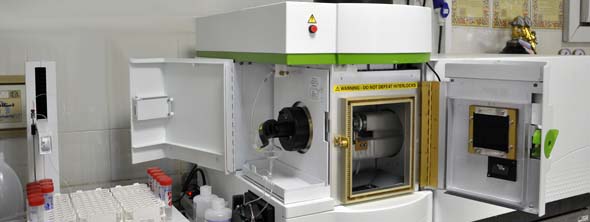Atomic absorption spectroscopy involves the study of absorption of radiant energy absorbed by neutral atoms in gaseous state.
In an analysis by an atomic absorption spectroscopy machine measuring element evaporates by flame and reduces to elemental form
and by this technique, atomic absorption spectroscopy machine are used for qualitative and quantitative detection of different types
of metals in all kinds of materials and solutions. Approximately 30 elements are measured by the device. This equipment accuracy is ppm.
For sample analysis by this devices sample must be resolved in inorganic acids (mineral acids) and finally, it must be inserted. For each
element
special lamp of that element is required. Elements such as Au, Ag, Al, Mn, Sn, Zn, Cu, is this by this equipment.

Installation and Setup of ICP Equipment
Recently, Optima 8000 ICP-OES equipment has been installed and set up at RMRC chemistry laboratory and is currently operative.
Inductively Coupled Plasma Optical Emission Spectrometry (ICP-OES) is one of the most important instrumental methods for the analysis
of chemical elements both qualitatively and quantitatively. This method can be used for determining the
concentration of 70 chemical elements in various samples including soil, water, metals, ceramics, and organic
materials. Due to the high repeatability and compatibility of ICP-OES, results are precise and accurate.
This method is based on the excitation of electrons of various elements
in plasma atmosphere (as an excitation source) and the analysis of subsequent
light emission of their ions. In this method a flow of Ar is ionized by a MHZ 40-20 magnetic
field and produces a heat amount of close to 1000K. The sample is then sprayed into the Ar plasma
and transforms to ions and subsequently radiates. The intensity of radiation is then measured by the equipment.
The range of application for ICP-OES
Applications in Geology: determining the concentration of chemical elements in soil, stones and sediments after dissolution
by accelerators or in acids.
Applications in Biology: determining the concentration of trace metallic elements in water, soil,
and sediments after dissolution and pre-concentration.



